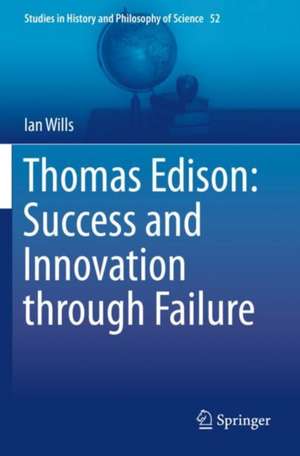Thomas Edison: Success and Innovation through Failure: Studies in History and Philosophy of Science, cartea 52
Autor Ian Willsen Limba Engleză Paperback – 5 mai 2021
| Toate formatele și edițiile | Preț | Express |
|---|---|---|
| Paperback (1) | 365.38 lei 38-44 zile | |
| Springer International Publishing – 5 mai 2021 | 365.38 lei 38-44 zile | |
| Hardback (1) | 378.70 lei 38-44 zile | |
| Springer International Publishing – 2 ian 2020 | 378.70 lei 38-44 zile |
Din seria Studies in History and Philosophy of Science
- 15%
 Preț: 650.19 lei
Preț: 650.19 lei - 15%
 Preț: 700.75 lei
Preț: 700.75 lei -
 Preț: 284.47 lei
Preț: 284.47 lei - 15%
 Preț: 702.24 lei
Preț: 702.24 lei -
 Preț: 389.88 lei
Preț: 389.88 lei - 18%
 Preț: 1222.94 lei
Preț: 1222.94 lei - 15%
 Preț: 647.08 lei
Preț: 647.08 lei - 15%
 Preț: 645.47 lei
Preț: 645.47 lei - 18%
 Preț: 956.33 lei
Preț: 956.33 lei - 18%
 Preț: 953.97 lei
Preț: 953.97 lei - 15%
 Preț: 646.11 lei
Preț: 646.11 lei - 15%
 Preț: 641.85 lei
Preț: 641.85 lei - 15%
 Preț: 644.49 lei
Preț: 644.49 lei - 18%
 Preț: 951.29 lei
Preț: 951.29 lei - 15%
 Preț: 647.40 lei
Preț: 647.40 lei - 18%
 Preț: 953.20 lei
Preț: 953.20 lei - 18%
 Preț: 946.87 lei
Preț: 946.87 lei - 18%
 Preț: 1384.56 lei
Preț: 1384.56 lei - 18%
 Preț: 1234.14 lei
Preț: 1234.14 lei - 15%
 Preț: 637.78 lei
Preț: 637.78 lei - 15%
 Preț: 633.53 lei
Preț: 633.53 lei - 18%
 Preț: 1219.77 lei
Preț: 1219.77 lei - 24%
 Preț: 586.95 lei
Preț: 586.95 lei - 18%
 Preț: 967.56 lei
Preț: 967.56 lei - 15%
 Preț: 641.38 lei
Preț: 641.38 lei - 15%
 Preț: 642.68 lei
Preț: 642.68 lei - 15%
 Preț: 642.03 lei
Preț: 642.03 lei - 15%
 Preț: 641.85 lei
Preț: 641.85 lei
Preț: 365.38 lei
Nou
Puncte Express: 548
Preț estimativ în valută:
69.92€ • 75.93$ • 58.74£
69.92€ • 75.93$ • 58.74£
Carte tipărită la comandă
Livrare economică 18-24 aprilie
Preluare comenzi: 021 569.72.76
Specificații
ISBN-13: 9783030299422
ISBN-10: 3030299422
Pagini: 257
Ilustrații: VII, 257 p. 75 illus., 27 illus. in color.
Dimensiuni: 155 x 235 mm
Ediția:1st ed. 2019
Editura: Springer International Publishing
Colecția Springer
Seria Studies in History and Philosophy of Science
Locul publicării:Cham, Switzerland
ISBN-10: 3030299422
Pagini: 257
Ilustrații: VII, 257 p. 75 illus., 27 illus. in color.
Dimensiuni: 155 x 235 mm
Ediția:1st ed. 2019
Editura: Springer International Publishing
Colecția Springer
Seria Studies in History and Philosophy of Science
Locul publicării:Cham, Switzerland
Cuprins
Chapter 1. Introduction.- Part I: Edison and Failure Chapter.- 2. Success, Failure and Innovation: the Carbon Microphone.- Chapter 3. Failure and Success.- Chapter 4. Innovation and Systems.- Chapter 5. Innovation Must Fail.- Chapter 6. Catastrophic Failure.- Part II: Edison Science and Invention.- Chapter 7. Inventive Success: the Phonograph.- Chapter 8. Scientific Failure: Etheric Force.- Part III: Edison's World.- Chapter 9. Thomas Edison and Patents.- Chapter 10. The Edisonian Method: Trial and Error.- Part IV: Reversing Edison.- Chapter 11. Reverse Engineering.- Chapter 12. Epilogue.- Bibliography.- Notes.
Notă biografică
Ian turned to the history and philosophy of science after a career in engineering. His PhD dissertation focused on the history and philosophy of technology using Thomas Edison’s laboratory notebooks to understand the processes by which novel artefacts are created.
Subsequent work included industrial heritage in Australia; the science of F W Taylor's Scientific Management; and the Great Strike of 1917. His current interests include Australia's failed attempt to build nuclear weapons; the history of manufacturing in Australia; and manufacturing’s interaction with Australian history more broadly.
Subsequent work included industrial heritage in Australia; the science of F W Taylor's Scientific Management; and the Great Strike of 1917. His current interests include Australia's failed attempt to build nuclear weapons; the history of manufacturing in Australia; and manufacturing’s interaction with Australian history more broadly.
Textul de pe ultima copertă
This book develops a systematic approach to the role of failure in innovation, using the laboratory notebooks of America's most successful inventor, Thomas Edison. It argues that Edison's active pursuit of failure and innovative uses of failure as a tool were crucial to his success. From this the author argues that not only should we expect innovations to fail but that there are good reasons to want them to fail. Using Edison's laboratory notebooks, written as he worked and before he knew the outcome we see the many false starts, wrong directions and failures that he worked through on his way to producing revolutionary inventions. While Edison's strengths in exploiting failure made him the icon of American inventors, they could also be liabilities when he moved from one field to another. Not only is this book of value to readers with an interest in the history of technology and American invention, its insights are important to those who seek to innovate and to those who employ and finance them.
Caracteristici
Argues for the revolutionary proposal that in innovation, failure is not something to avoid but something to be actively pursued Showing how Thomas Edison, America's most prolific and successful inventor, both embraced failure but used it in innovative ways as a tool when inventing Develops a systematic theoretical approach to the role of success and failure in innovation, introducing the concepts of success criteria, success frameworks and functional systems
